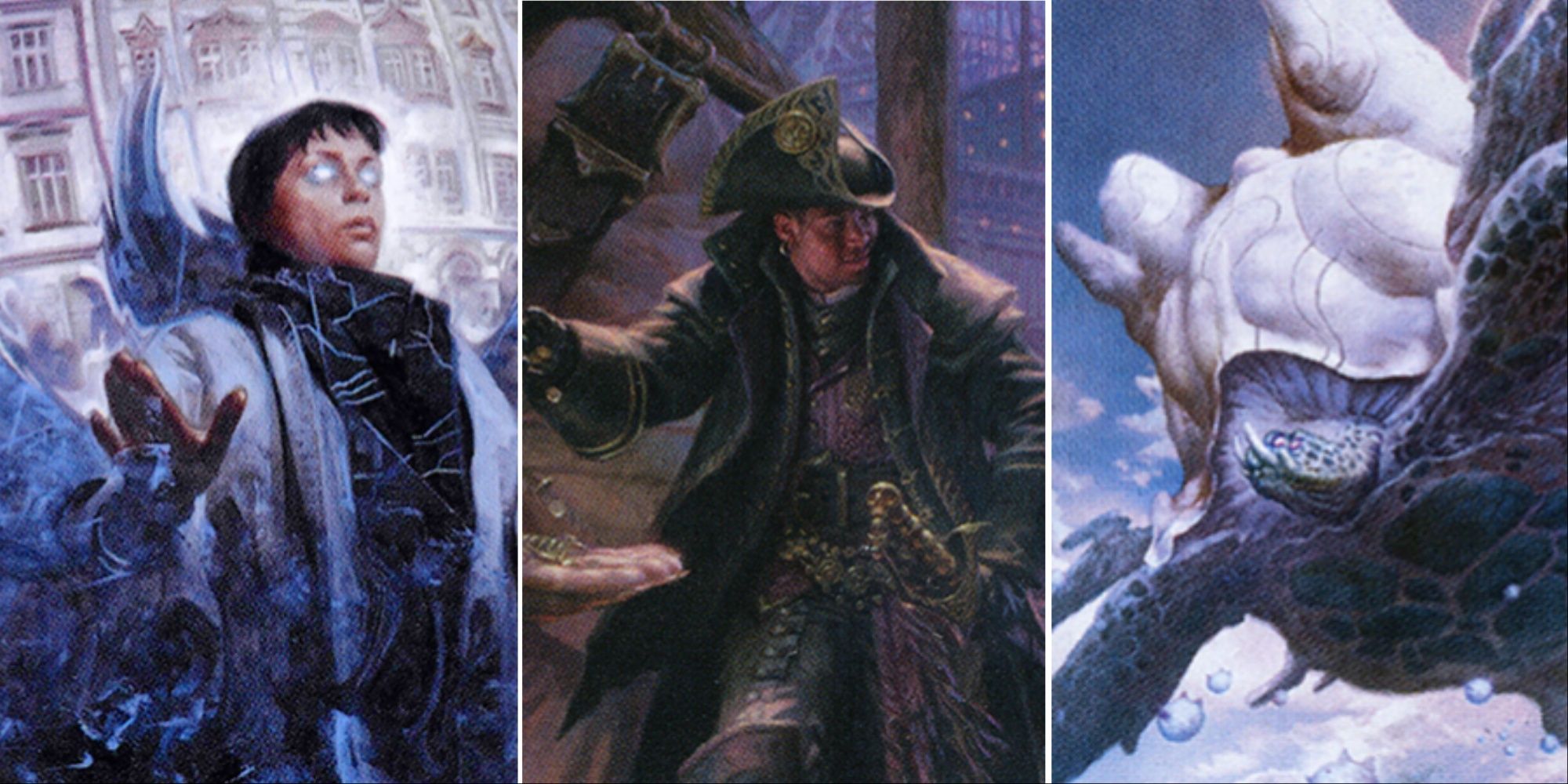Magic: The Gathering - 10 Hidden Archetypes In Limited Formats

Limited formats in Magic: The Gathering have a tried and true formula when it comes to deliberately planted archetypes. There's usually an intended theme for each color pair in a set, earmarked by one or two uncommon multicolor cards that clearly showcase what that color pair is supposed to be doing. This serves as guidance if you aren't familiar with the set, and provides opportunities for clear signaling during the draft portion.
Related: Magic: The Gathering - The Best Sets To Draft
There's something special that happens when you discover an archetype or strategy that wasn't explicitly seeded by the designers. These 'hidden' archetypes come about through exploration, and sometimes become so exciting that they end up being the decks that everyone remembers most fondly when looking back at a set.
10 Spider Spawning - Innistrad
Spider Spawning is perhaps the most well-known and talked about hidden archetype ever to surface out of a format, at a time before signpost uncommons became the norm for Limited. This deck took some time to discover and involved quite a few moving parts to come together, but it's the first thing that many players think about when discussing Innistrad drafts.
Spider Spawning combined its namesake card with self-mill effects, Memory's Journey, and Runic Repetition to stabilize the board, then positions itself to flood the battlefield with Spider tokens every turn for the rest of the game.
9 Turtle Loops - Kamigawa: Neon Dynasty
NEO Limited was absolutely brimming with ingenuity. With so many knobs and buttons to play around with, it's no wonder a few secret decks snuck through the cracks, the most prominent among these being recursive Colossal Skyturtle strategies.
Skyturtle was already a sizable threat on the battlefield, but the 'Regrowth' mode allowed it to loop with other cards, namely Season of Renewal and Shigeki, Jukai Visionary. Each of these could return the others, picking up other cards in the process, which resulted in a late-game card advantage engine that easily out-valued what most other decks were doing.
8 Clear The Mind - Ravnica Allegiance
Ravnica Allegiance was built around two-color guilds, and yet somehow the format seemed to revolve around a three-color deck whose signature card was a mono-colored sorcery. You know, typical Ravnica stuff.
Related: Magic: The Gathering - Every Ravnica Set, Ranked
Clear the Mind had a lot working in its favor. Blue-White-Black decks were full of interaction, card draw was plentiful, and Dovin's Acuity plus the addendum ability offered incentives for casting spells regardless of what they did. The real kicker was the fact that two Clear the Minds looped with one another, giving you an inevitable, if unclear, route to victory in a prolonged game.
7 Slither Blade Cartouches - Amonkhet
A cleverly concealed archetype isn't always a great one. While some players wrote this deck off as a joke, others deemed the 'Slither Blade' deck an undervalued gem in Amonkhet Limited. Christian Calcano even had enough confidence to draft six Slither Blades during a Pro Tour Amonkhet draft.
The deck idea was simple. Get unblockable Slither Blades online, suit them up with Cartouches, and slip through your opponent's defenses. It's similar to a Constructed Bogles deck... except for the hexproof. Without protection, a single well-timed removal spell could shut down the entire strategy.
6 Sailor Of Memes - Rivals Of Ixalan
Despite being somewhat lackluster in Ixalan, Sailor of Means made a name for itself when it was immediately reprinted in Rivals of Ixalan. Rivals slowed down the notoriously fast triple-Ixalan format, and the Means became Memes real fast.
Rivals was a bomb-heavy format, and Sailor of Means was perfect at not only holding down the fort and bridging your way into the late-game, but also providing Treasure to ramp into and fix colors for you finishers. So called 'Sailor of Means' decks wanted to load up on Sailors and game-winning threats, regardless of cost or color.
5 Five-Color Great Hall - Lord Of The Rings
Tales of Middle-earth looked like a solved format from the onset. It became clear almost immediately how powerful black was and by comparison how poorly positioned green was. And yet, through iteration and persistence, players found a home for green as the base of a five-color legends deck centered around Great Hall of the Citadel.
Related: Magic: The Gathering – What Are Lord Of The Rings: Tales Of Middle-earth's Limited Archetypes?
Citadel single-handedly fixed your colors for legendary cards, which were already among the best cards in the format. Green supplemented the deck with other fixing options like Many Partings and Wose Pathfinder, though the deck's popularity made it harder to find Citadels.
4 Arcane Dampen Thought - Champions of Kamigawa
There's a real edge to discovering a hidden strategy that players aren't accustomed to, especially when it revolves around cards that players don't usually want. The Dampen Thought deck from Champions of Kamigawa was one such strategy, looking to combine underdrafted cards into a game-winning deck.
The idea was straightforward: splice Dampen Thought onto as many Arcane spells as possible and mill the opponent out. Bonus points if those Arcane spells were also disruptive cards like Glacial Ray. The pieces of the deck resurfaced in Modern Masters 1, though the strategy was more transparent by then.
3 Epitaph Golem Self-Mill - Shadows Over Innistrad
Expectations for Shadows Over Innistrad were high considering the success and popularity of the original Innistrad set. Shadows delivered, sculpting one of the best graveyard-centric formats of all time. The flexibility of the Limited format also encouraged creative deck-building.
Epitaph Golem headlined its own unique archetype. These decks milled away their entire library, then leaned on the Golem to set up their draws each turn. Rares like Ever After and Seasons Past slotted in perfectly, giving you reassurance from fully milling yourself out and providing ways to get your Golem back if it died.
2 Vent Sentinel Defenders - Rise Of The Eldrazi
The defender theme is woven into Limited formats from time to time, most notably as a top-tier deck from Dominaria United, and as a fully-supported archetype in Iconic Masters. While cards like Doorkeeper and Wingmantle Chaplain use defenders in completely different ways, Vent Sentinel was frontlining this strategy way back in Rise of the Eldrazi.
Related: Magic: The Gathering – The Best Temur Commanders
ROE is well-known as one of the slowest, grindiest formats ever, lending itself to slow-paced accumulation of resources and gradually escalating threats. The snail's crawl environment allowed you to deploy defenders without being under much pressure and ride the Vent Sentinels to victory.
1 Zenith Flare Cycling - Ikoria
Ikoria's Zenith Flare deck wasn't exaclty 'hidden' since the card advertised exactly what it wanted to do and served as a signpost Red-White uncommon. What players didn't expect going into the format was just how powerful the card would be, and how easily you could turn it into a wincon.
Forget about Companions and Mutate, Cycling was the story of Ikoria Limited, all thanks to this one card. A surplus of cheap cyclers made it trivially easy to find your Zenith Flare(s) and charge them up to the point where they were dealing more than ten damage.
Next: Magic: The Gathering - Top Budget Dual Land Cycles













